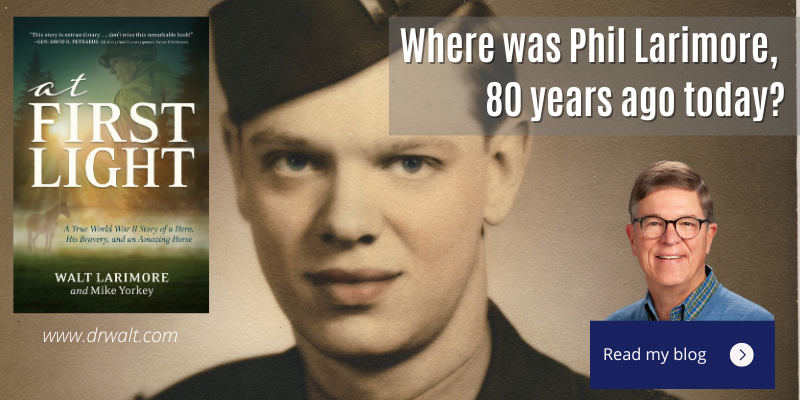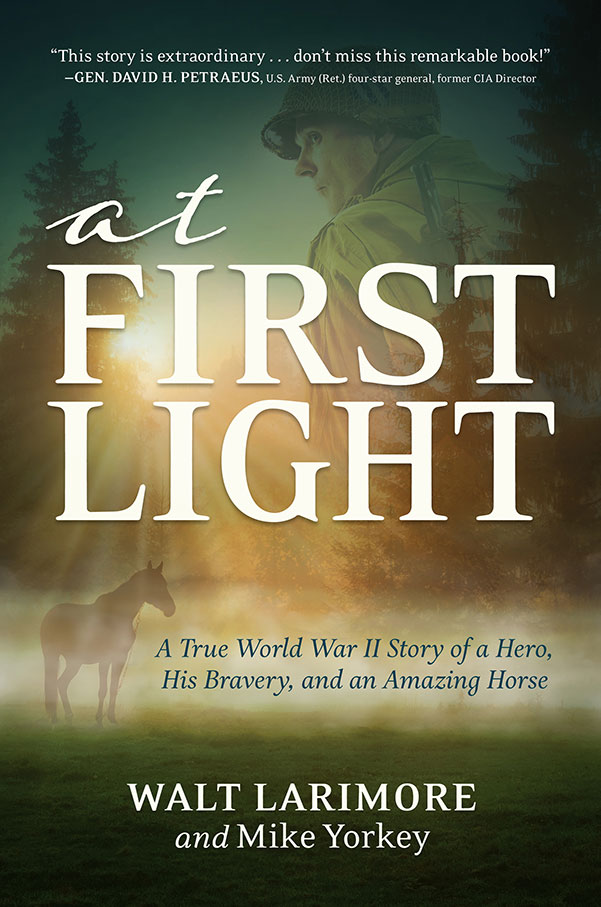
February 11, 1944 – A teenage WWII hero writes home from French Morocco
February 11, 2024
February 13, 1944 – A teenage WWII hero rides a train to the war
February 13, 2024Phil had written his mother about letting “a cute girl that I met near camp teach me French.” He also learned from her about a Moroccan tradition called lab al baroud or the “gunpowder game” in which horsemen wearing traditional garb charge in a single line at the same speed firing their moukhalas, or muskets, into the air in unison.

The young girl told Phil that soldiers could participate on a nearby beach where some nomadic horsemen had set up camp.
Phil was able to obtain a pass and a Jeep for the short drive. At the encampment, she introduced Phil to an English-speaking Arab who would serve as his guide. The young man first took him to meet the horses.
“Arabian horses,” he explained, “are a breed that began here over a thousand years ago. What you are seeing is the result—a bold, fearless horse that is as comfortable in the desert as in the mountains, an incredibly strong and versatile animal.”
Looking across the herd, all contentedly eating hay, Phil noted, “They seem to come in many colors.”
“Yes, all colors, and as you can see, with a gorgeous metallic sheen to their coat.”
“Your English is excellent,” Phil commented.
“My parents sent me to London for my education. But my love of Morocco and these horses brought me back.”
Phil ran his hand along a magnificent stallion. Its neck was long and muscular, and its chest was wide. He then ran his hand along its high withers, noting the short but muscular back. The horse shook its head, and Phil ran his hand through the plush mane.
“See how long and thick the mane and tail are? Helps protect him from the desert flies, which can be fierce.”
Two men dressed in flowing white garments trotted by on their Arabian horses. Phil turned to his guide. “I expected a clunky gait. But they’re quite graceful.”
The man smiled. “You know your horses, sir. They have an exceptionally smooth trot, which makes them incredibly comfortable to ride. The breed is so characterized by its flowing gait that they are highly valued by the Moroccan royal family. Of course, it seems royal families in every country have their preferred breed. In Europe, they are the Arabian, Andalusian, Friesian, and Lipizzaner breeds. But for us Moroccans, it’s this one, which is why we have a saying about the Arabians: ‘Nobility without arrogance, loyalty without jealousy, splendor without pride—a faithful servant but never a slave.’”
Phil smiled. “When I was growing up,” he said wistfully, “an Austrian with the world-famous Lipizzaners told me that among equestrians from around the world, ‘Our hoofbeats were many, but our hearts beat as one.’”
The Moroccan guide nodded. “It’s true, my friend. But let’s get you dressed and ready for the charge.”
The young man took Phil to a tent and outfitted him with a long flowing white gown and a turban. A quick lesson on loading and firing a native musket was followed by a brief demonstration of the foot and knee movements required to guide his horse. The young man explained that the musket had to be held with both hands above shoulder level when fired during the charge. In no time, Phil mastered the technique, much to the delight of his guide.
The riders lined up on the beach, and at a pistol-shot signal, raced together in a single line at the same speed and then raised and fired their moukhalas in unison, the sounds of the shots blending into a single, overpowering burst of sound and gunpowder.
After several reloads and repeat charges, the men trotted back to the makeshift stable to feed and brush the horses, followed by the drinking of traditional mint tea and snacking on Moroccan almond cookies and sweets.
Phil’s guide explained more about lab al baroud. “This reenactment is practiced all across North Africa and dates back to the eighth century. The cavalry charge began during what we call the ‘Islamic Golden Age,’ when cavalry maneuvers were performed as displays of power to intimidate enemy armies. The custom of firing the muskets was added after gunpowder and guns arrived in the region in the early 13th century. Since then, it’s been popular with tribesmen as well as tourists.”
“Tourists?”
“Of course. The most famous perhaps was the French painter Delacroix. Do you know of him?”
Phil nodded.
“Delacroix[1] visited Morocco in 1832, participated in lab al baroud and did a series of sketches and paintings of our people and our horses. He introduced Europeans to our traditions, and we’ve hosted tourist caravans ever since. And now, we have you American and British soldiers to help us carry the tradition back to your homes.”
Phil lifted his teacup to his new friend. “May I make it home.”
“From your lips to the ears of Allah,” the man replied solemnly as their teacups clinked together.
Phil soaked in every minute of the exotic experience, pinching himself the entire time.
[1] Ferdinand Victor Eugène Delacroix (1798–1863), son of a noble family from Paris and called the “greatest French Romantic painter,” visited Morocco in 1832 as part of a French diplomatic mission. His many drawings and annotations were made in seven sketchbooks during the trip.
© Copyright WLL, INC. 2024.





